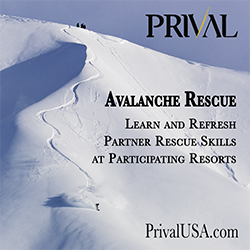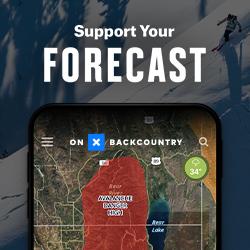Forecast for the Provo Area Mountains

Issued by Nikki Champion on
Thursday morning, December 23, 2021
Thursday morning, December 23, 2021
The avalanche danger is CONSIDERABLE on all steep slopes at upper elevations and mid-elevation slopes facing northwest, through the north, through east, where recent storm snow and winds have created a dense slab of snow on top of a buried persistent weak layer. Avalanches initially triggered within the wind drifted snow or new snow can step down into deeper weaker layers.
The avalanche danger is MODERATE on mid-elevation slopes facing west, southwest, south, and southeast.
The remaining aspects and elevations have a LOW danger.
As this storm moves into the area we will have dangerous avalanche conditions, and conservative decision-making will be essential today. Slab avalanches 1-3 feet deep, and hundreds of feet wide are likely. These are unsurvivable avalanche conditions. Low-angle terrain continues to be your best option.
HEADS UP: With lots of wind & snow in the forecast, the avalanche danger will be on the rise starting this afternoon and will continue to be dangerous through the holiday break. Please share the word with friends, family, and riding partners that conditions will continue to be dangerous and deadly here in Northern Utah, especially as the new snow stacks up. Be careful.

Low
Moderate
Considerable
High
Extreme
Learn how to read the forecast here
Avalanche Watch
THE AVALANCHE DANGER IS EXPECTED TO RISE RAPIDLY TODAY.
AN AVALANCHE WATCH HAS BEEN ISSUED FOR THE MOUNTAINS OF MUCH OF THE STATE OF UTAH, INCLUDING THE WASATCH RANGE...BEAR RIVER RANGE...UINTA MOUNTAINS...AND THE MANTI-SKYLINE..
HEAVY DENSE SNOWFALL AND STRONG WINDS WILL LIKELY CREATE VERY DANGEROUS AVALANCHE CONDITIONS. BOTH HUMAN TRIGGERED AND NATURAL AVALANCHES ARE LIKELY. STAY OFF OF AND OUT FROM UNDER SLOPES STEEPER THAN 30 DEGREES.
 Weather and Snow
Weather and Snow
This morning, skies are overcast and snow has lightly begun falling with no real accumulation yet. Currently, the mountain temperatures hover in the mid 30's °F at the mid and upper elevations. The southwesterly winds have bumped up in speed overnight, with speeds of 15-25 mph, with the highest gusts hitting 30 mph across the mid-elevation ridgelines and gusts up to 60 mph at the uppermost elevations.
Today, the long-anticipated storm will begin. Temperatures will climb into the mid-30s °F. Right around sunrise light snow showers will begin, becoming more widespread in the afternoon. Steady snowfall will generally hold off until 3-5 PM this afternoon. We could expect 2-4" of new snow before dinner time.
The Southwesterly winds will remain sustained averaging 20-30 mph, gusting near 55 mph at mid-elevation and upper-elevation ridgelines.
Tonight, the snowfall begins to kick up. Peak precipitation intensities will occur between 11 PM tonight into 11 AM Friday, averaging 2" of snow per hour (0.2" water/hour). With the high snowfall totals, winds will remain elevated with gusts up to 55 mph at mid-elevations and gust up to 80 mph at upper elevations.
Snow totals for the Provo area mountatins are expected to be 24-32"(2.6-3.6" H2O) by Saturday.
There is still plenty of good riding to be found in the backcountry. Southerly slopes have begun to crust over with the multiple days of sunshine, but any shaded terrain still holds soft cold snow. With these past few cold-clear nights, the surface snow in protected, non-solar facing terrain has begun to facet and weaken. While this makes for fine riding conditions today, as the next storm moves into the area, the new snow may bond poorly to the old snow in these areas or become another weak layer in the future.
 Recent Avalanches
Recent Avalanches
There was one report of a human-triggered avalanche from the Provo Area yesterday. The skier triggered an avalanche in Snake Creek, while traveling uphill. The avalanche was triggered on a North-facing slope at 9900' and failed approx 2' deep and 100' wide on facets.
Find the full observation HERE.
Reports of large booming collapses and poor snowpack structure continue to be observed by backcountry travelers.
Avalanche Problem #1
Persistent Weak Layer
Type
Location
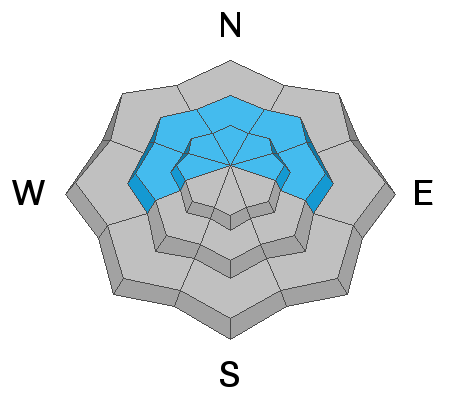
Likelihood
Size
Description
Dangerous avalanche conditions exist on mid and upper elevation slopes facing West through North through Eaast where storm snow, and wind-blown snow has overloaded weak, faceted snow in the bottom of the snowpack. As we continue to add more snow, and more wind going into this weekend these avalanches will only become larger, more destructive, and more deadly. Avalanches may break down 1-3' deep, possibly deeper, and propagate hundreds of feet wide. Either way, these avalanches are likely to be unsurvivable.
A few words of caution:
- Signs of instability may not always be present: you may or may not see or experience shooting cracks or audible whumping.
- Tracks on the slope offer zero signs of stability. Avalanches will take out multiple existing tracks.
- You can trigger these avalanches from a distance or below.
- Any fresh wind slab or new snow avalanche may step down into this older layering of weak snow.
Bottom Line: There is no outsmarting this problem - avoidance is the answer. If you're traveling on the shady side of the compass, be sure to stick to terrain that's under 30° degrees in slope steepness with nothing steep above or adjacent to you. Dangerous avalanche conditions exist, and human-triggered avalanches are likely.
Video from Tuesday, where Francine and I went a looked at a large recent avalanche off of the Park City Ridgeline. The poor snowpack structure remains obvious. As we move into the next storm system we will continue to overload and stress the weak faceted snow leading to more large and destructive avalanches. Check out the full observation HERE.
Avalanche Problem #2
Wind Drifted Snow
Type
Location
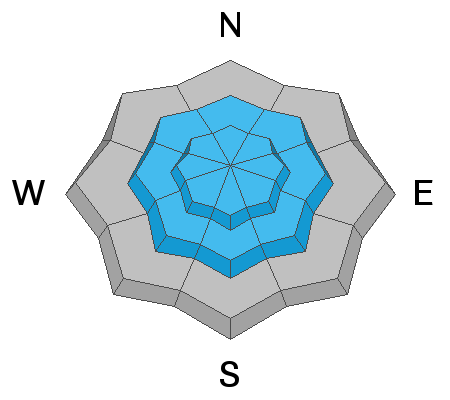
Likelihood
Size
Description
Over the last 24 hours, the Southwesterly winds began to pick up. With new snow on the horizon and lingering soft snow in protected areas, even a small bump in winds will begin drifting snow. Sustained high winds can deposit snow around terrain features on almost any aspect, called cross-loading. For this reason, I would expect to find slabs of wind drifted snow forming at all upper and mid-elevation slopes, especially along with terrain features such as ridgelines, sub ridges, and gullies. These wind drifts will be particularly touchy at upper elevation aspects facing west through north through east due to the direction of the wind, and where the wind drifted snow will be sitting on top of the weak faceted snow. Any wind drifted snow or new snow avalanche triggered can step down into deeper weaker layers creating a much larger avalanche.
Strong to moderate winds today will form both soft and hard slab avalanches in mid and upper elevation wind drifted terrain. As the winds continue to blow, these slabs will become more firm and cohesive. This can allow you to travel out farther onto the slope before it breaks, and can fail larger and wider than expected. Approach each new drift with caution, cracking and collapsing may not be evident today.
Today look for slopes with any signs of wind drifted snow, such as cracking, hollow noises, and pillow-shaped snow, and avoiding those slopes.
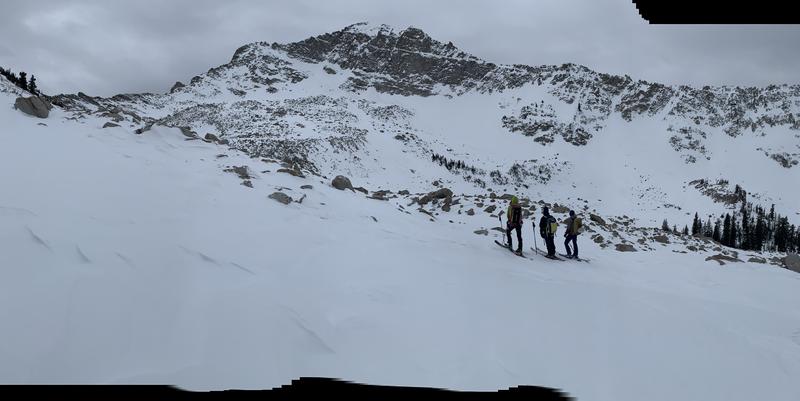
Drew noted significant scouring and drifting yesterday in White Pine. Find his full observation HERE.

General Announcements
Who's up for some free avalanche training? Get a refresher, become better prepared for an upcoming avalanche class, or just boost your skills. Go to https://learn.kbyg.org/ and scroll down to Step 2 for a series of interactive online avalanche courses produced by the UAC.
This information does not apply to developed ski areas or highways where avalanche control is normally done. This forecast is from the U.S.D.A. Forest Service, which is solely responsible for its content. This forecast describes general avalanche conditions and local variations always occur.



